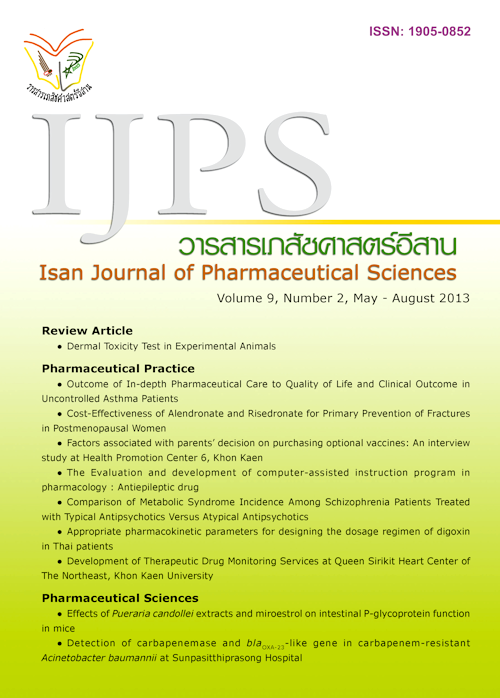Effects of Pueraria candollei extracts and miroestrol on intestinal P-glycoprotein function in mice
Main Article Content
Abstract
Introduction: Pueraria candollei Wall. ex Benth. var. mirifica (family Leguminosae), as known Kwao Kruea Khaw in Thai, has been widely used in Thai traditional medicine and is supplied in commercial health products for rejuvenation. It is interesting to investigate the potential effect of P. candollei and its component, miroestrol, on P-glycoprotein function to provide the important drug-herb interaction data for applying in clinical relevance. Objective: This present study is investigated the effect of P. candollei extract and miroestro, the potent phytoestrogen found in P. candollei on P-glycoprotein, the efflux transporter, function. Materials and Methods: Determine effect of substances on P-glycoprotein function by employing the in vitro transport of rhodamine 123, a substrate of P-glycoprotein, across everted intestinal sac was studied in mice. The ability of P. candollei tincture and the P. candollei ethyl acetate extract fraction to inhibit p-glycoprotein function were examined. Results: P. candollei extract has no effect on P-glycoprotein function. Miroestrol showed negligible inhibitory effect on P-glycoprotein function at the concentration at 100 µM and higher. For expression of P-glycoprotein, change in expression of ABCB1 and ABCB2 mRNAs in mice administered with miroestrol at 0.5 mg/kg/day subcutaneously for 7 days was not observed. Conclusion: Miroestrol, and P. candollei extracts have negligible effect on p-glycoprotein function. However, the effect of phytoestrogens contained in the tuberous root of P. candollei on P-glycoprotein and other protein transporters after long term of administration should be further investigated.
Article Details
In the case that some parts are used by others The author must Confirm that obtaining permission to use some of the original authors. And must attach evidence That the permission has been included
References
Albertazzi P, Pansini F, Bottazzi M, Bonaccorsi G, De Aloysio D, Morton MS. Dietary soy supplementation and phytoestrogen levels. Obstet Gynecol 1999;94:229-31.
Benson GK, Cowie AT, Hosking ZD. Mammogenic activity of miroestrol. J Endocrinol 1961;21:354-60.
Branda W, Schutteb ME, Williamsona G, et al. Rietjensb IMCM. Flavonoid-mediated inhibition of intestinal ABC transporters may affect the oral bioavailability of drugs, food-borne toxic compounds and bioactive ingredients. Biomedicine 2006;60:508–19.
Chansakaow S, Ishikawa T, Seki H, et al. Identification of Deoxymiroestrol as the actual rejuvenating principle of “Kwao Keur”, Pueraria mirifica. The known miroestrol may be an artifact. J Nat Prod 2000;63(2):173-5.
Cherdshewasart W, Sriwatcharakul S. Metabolic activation promotes estrogenic activity of the phytoestrogen-rich plant. Maturitas 2008;59:128-36.
Davies B, Morris T. Physiological parameters in laboratory animal and humans. Pharm Res 1993;10:10:1093-5.
Gottesman MM, Pastan I. Biochemistry of multidrug resistance mediated by the multidrug transporter. Annu Rev Biochem 1993; 62: 385-427
Jones HEH, Waynforth HP, Pope GS. The effect of miroestrol on vaginal cornification, pituitary function and pregnancy in the rat. J Endocrinol 1961;22:293-302.
Leonard GD, Fojo T, Bates SE0. The role of ABC transporters in clinical practice. The oncologist 2003; 8:411-24.
Limtrakul P, Khantamat O, Pintha K. Inhibition of P-glycoprotein function and expression by kaempferol and quercetin. J Chemother. 2005 Feb;17(1):86-95.
Lin JH, Yamazaki M. Role of p-glycoprotein in pharmacokinetics clinical implications. Clin Pharmacokinet 2003; 42 (1): 59-98.
Malaivijitnond S, Kiatthaipipat K, Cherdshewasart W, Watanabe G, Taya K. Different effects of Pueraria mirifica, a herb containing phytoestrogens, on LH and FSH secretion in gonadectomized female and male rats. J Pharm Sci 2004;96:428-35.
Ruetz S, Gros P. Phosphatidylcholine translocase: a physiological role for the mdr 2 gene. Cell 1994; 77: 1071-81
Schinkel AH. The physiological function of drug-transporting P- glycoproteins. Cancer Biol 1997; 8: 161-70
Takano M, Yumoto R, Murakami T. Expression and function of efflux drug transporters in the intestine. Pharmacol Ther 2006;109:137–61.
Trisomboon H, Malaivijitnond S, Watanabe G, Taya K. Ovulation block by Pueraria mirifica: a study of its endocrinological effect in female monkeys. Endocrine 2005;26:33-40.
Udomsuk L, Churikawit K, Putalun W, Jarukamjorn K. Impact of Pueraria candollei root cultures on cytochrome P450 2B9 enzyme and lipid peroxidation in mice. J Health Sci 2010;56(2):182-7.
van Helvoort A, Smith AJ, Sprong H, et al.. MDR1 P-glycoprotein is a lipid translocase of broad specificity, while MDR3 P-glycoprotein specifically translocates phosphatidylcholine. Cell 1996; 87: 507-17
Yumoto R, Murakami T, Yuko Nakamoto, Hasegawa R, Nagai J, Mikihisa Takano. Transport of rhodamine 123, a p-glycoprotein Substrate, across Rat Intestine and Caco-2 cell monolayers in the presence of cytochrome P-450 3A-related Compounds. JPET 1999;289:149 –55.


